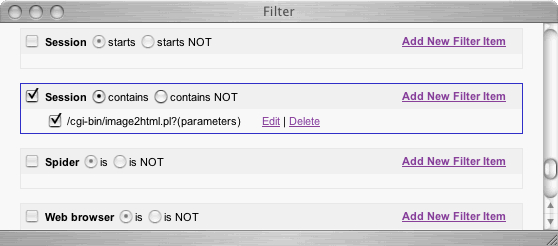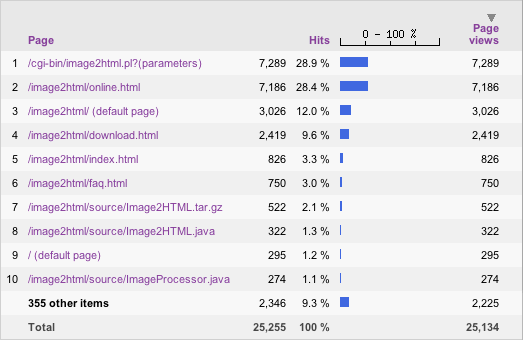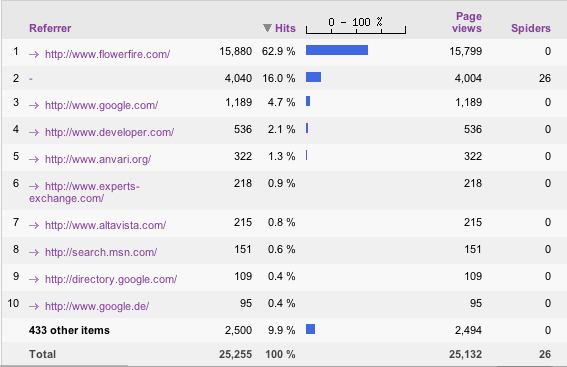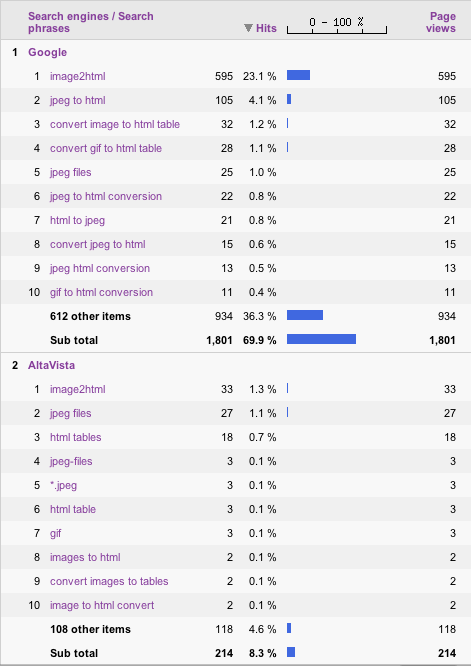Newsletters
 |
Sawmill Newsletter June 15, 2007 |
Welcome to the Sawmill Newsletter!
You're receiving this newsletter because during the downloading or purchase of Sawmill, you checked the box to join our mailing list. If you wish to be removed from this list, please send an email, with the subject line of "UNSUBSCRIBE" to newsletter@sawmill.net .
News
We are currently shipping Sawmill 7.2.9. You can get it from http://sawmill.net/download.html .
This issue of the Sawmill Newsletter describes the "session contains" report filter, and how it can be used to track conversions from their source.
Get the Most out of Sawmill with Professional Services
Looking to get more out of your statistics from Sawmill? Running short on time, but need the information now to make critical business decisions? Our Professional Service Experts are available for just this situation and many others. We will assist in the initial installation of Sawmill using best practices; work with you to integrate and configure Sawmill to generate reports in the shortest possible time. We will tailor Sawmill to your environment, create a customized solution, be sensitive to your requirements and stay focused on what your business needs are. We will show you areas of Sawmill you may not even be aware of, demonstrating these methods will provide you with many streamlined methods to get you the information more quickly. Often you'll find that Sawmill's deep analysis can even provide you with information you've been after but never knew how to reach, or possibly never realized was readily available in reports. Sawmill is an extremely powerful tool for your business, and most users only exercise a fraction of this power. That's where our experts really can make the difference. Our Sawmill experts have many years of experience with Sawmill and with a large cross section of devices and business sectors. Our promise is to very quickly come up with a cost effective solution that fits your business, and greatly expand your ROI with only a few hours of fee based Sawmill Professional Services. For more information, a quote, or to speak directly with a Professional services expert contact consulting@flowerfire.com.
Tips & Techniques: Tracking Conversions with a "Session Contains" Filter
In web analytics, a "conversion" is an event which indicates a success for the web site. If the web site is selling something, it can be a sale; if it is offering content, it can be someone viewing the content; if it is offering a subscription, it can be a visitor signing up. Most web sites have a specific purpose, tracking conversions can tell you how effectively your web site is accomplishing its purpose, and this can also lead to predicting the conversion rate.
Conversions are a more practical metric than hits or page views. Page views tells you how many pages were viewed, but if your web site is selling a product, a billion page views doesn't represent success, if nobody buys. Conversions represent concrete success.
Sawmill can track conversions using a flexible feature called the Session Contains filter. A Session Contains filter is a report filter, applied after the data is imported into the database, while reports are being generated. Whereas a more traditional filter might select all events from June, or all events which hit a particular page, a Session Contains filter selects entire sessions; specifically, it selects all events in all sessions which at some point accessed a particular page. For instance, if you apply a "session contains '/thanksforbuying.asp'" filter, it will select all events from all sessions containing a hit on /thanksforbuying.asp. So if a visitor entered at /index.asp, and then went to /buy.asp, and then went to /thanksforbuying.asp, all three of those events would be selected by the filter, and would appear in all reports when that filter is active, because they are all in a session containing /thanksforbuying.asp.
For example, consider a web site which provides a CGI script for image conversion. In this case, a conversion is marked by a hit on the CGI script, whose pathname is /cgi-bin/image2html.pl?(parameters). So in Sawmill's Reports interface, we click the Filter icon at the top, and in the "Session contains" section, create a new Session Contains filter to select sessions containing hits on /cgi-bin/image2html.pl?(parameters), by clicking "Add New Filter Item" and entering /cgi-bin/image2html.pl?(parameters) in the "Session contains" field of the New Session filter item window:

A Session Contains Filter

A Session Contains Filter Item
After applying this filter, the Pages report looks like this:

The Pages Report (With Session Contains Filter)
Without a filter, the Pages report would show the number of hits, page views, etc. on all pages, for the entire dataset. With the filter, this shows the number of hits, page views, etc. which occurred during sessions containing hits on /cgi-bin/image2html.pl?(parameters). For example, this shows information from only converted sessions; and it is not showing just the conversion events themselves, but all hits in the entire session containing the conversion event. This can be useful when trying to determine what causes conversions, because it shows which pages occurred in the session along with the conversion (typically, before the conversion), which might have contributed to the decision to convert.
But a more interesting report is the Referrers report. Now that the "Session Contains" filter is applied, we can click any report to see that report for just converted sessions. So let's look at Referrers:

The Referrers Report (With Session Contains Filter)
Remember, this report is based only on hits from converted sessions--this does not include any hits which were not part of a session that eventually converted. The first line is internal referrers--this site is hosted on www.flowerfire.com, so clicks from one page to another will show that as the referrer. The second line shows no referrer, which suggests that those are bookmarks--a large number of conversions are coming from people who have bookmarked the utility. The third line shows that Google has brought much of the converted traffic; further down there are other search engines, and a few sites which have linked it directly. By turning on full referrer tracking and zooming into these referrers, we could see exactly which page brought the conversions. If there are specific pages you advertise on, this report will show you which advertisements resulted in conversions, and how often.
We can see from Referrers that much of our converted traffic is brought by search engines. So let's find out more, in the "Search phrase by search engine" report:

The Search Engines by Search Phrases Report (With Session Contains Filter)
Again, we still have the Session Contains filter applied, so this report shows the search engines and search phrases for only the converted sessions. This tells us then, which of our search phrases, on which search engines are bringing conversions and how many. If these are paid search terms, this is particularly useful information.
Advanced Topic: Adding Numerical Fields to Count the Number of Conversions
The tables above don't actually count the number of conversions; they count the number of hits and page views in the converted sessions. To count the exact number of conversions, you can look at the number of sessions, but that only appears in session reports, not in standard reports like those above. The best way to track the number of conversion is to add a custom numerical database field, and use a log filter to set it to 1 every time the conversion page is seen, e.g.:
if (page eq "/cgi-bin/image2html.pl?(parameters)") then conversions = 1 |
Then add the conversions field as a column to any report and to the corresponding xref tables, for best performance, and you will see the number of conversions as a column in that report.
Advanced Topic: Adding Additional Numerical Fields for Revenue/Expense Analysis
The reports above are useful, but you can get the ultimate report by adding additional numerical fields. For more information, see the April 2007 Newsletter: Displaying a Click-through Ratio With Calculated Report Columns, for an example of adding additional numerical fields. The exact fields and calculations depend on the situation, but suppose we're selling something, and advertising it with pay-per-click search engine ads. The table above (search engines by search phrases) can then include additional columns, called "revenue" and "expense." The "expense" column would show the total amount of money spent on each search phrase, by summing the cost for each click, perhaps using a CFG map to look up the cost; see the December 2006 Newsletter: Using CFG Maps. The "revenue" would show the total amount of revenue generated by those sessions; it would be computed by summing the revenue of each conversion, extracted from the URL if available; looked up in a CFG map of order information otherwise. This gives a clear side-by-side revenue vs. expense analysis of each paid keyword (the same approach can be used for other types of advertisements) to help determine which advertisements are making money, and which ones are not. See the Gatelys Case Study for a case study of this approach in an online retailer.
Advanced Topic: Using Multiple Session Contains Filters For Scenario Analysis
You can use any number of "session contains" filters at the same time. So if you want to know how many sessions went to your FAQ page, and also converted, you can add two Session Contains filters, and all reports will show only sessions which contained both pages (Session Contains filters also support wildcards, for matching a class of pages). This can be used for scenario analysis, to see how often your site is being used in the way you intended. By using several report elements with progressively more detailed "session contains", e.g., "(sessions contains 'A')" on the first report element, then "(session contains 'A') and (session contains 'B')" on the second report element and "(session contains 'A') and (session contains 'B') and (session contains 'C')" on the third report element, it is possible to create a "funnel" report, showing how many people sessions got to the first stage, second stage, and third stage of a complex scenario.
Questions or suggestions? Contact support@sawmill.net . If would you like a Sawmill Professional Services expert to implement this, or another customization, contact consulting@sawmill.net .
[Article revision v1.1]
[ClientID: ]